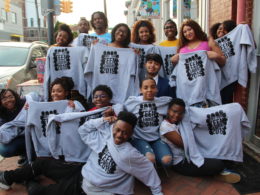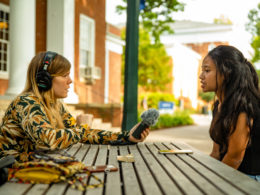Meet Cole’s Horse Autism Therapy Station (C.H.A.T.S), a York County-based nonprofit that pairs children with autism and a unique blend of equine therapy. Founded by Dr. Megan McGavern, in honor of her son Cole, the organization has become a resource for families navigating the challenges of autism.
McGavern embarked on a transformative journey after her son’s autism diagnosis at age 4. Determined to provide him with the best possible care, she delved into a relentless pursuit of healing and understanding. Her path took a pivotal turn upon discovering Rupert Isaacson’s book, “The Horse Boy.”
Driven by the desire to create a nurturing environment tailored to Cole’s needs, McGavern took the Horse Boy Method (HBM) – a therapeutic approach rooted in the principles of nature, movement and following the child’s lead – and developed a homeschooling program after her own model, the Movement Method.
In 2019, McGavern and her husband acquired nearly 18 acres of land in York County, laying the foundation for what she envisioned as a “Horse Boy masterpiece.” Later, with the addition of specially trained therapy horses, Majana, Diego and Neron, the journey toward transformation began.
From remarkable milestones in communication with Cole to newfound joys like beach outings, McGavern saw firsthand the profound impact of equine therapy in her son’s life. With C.H.A.T.S, she seeks to extend the same transformative opportunities to other families in the community, embodying a spirit of strength, community and hope.
“When we started C.H.A.T.S, our goal was simple: to provide a safe and nurturing environment where children with autism could thrive,” said Cassie Jensen, C.H.A.T.S coordinator.
Understanding the C.H.A.T.S approach
Harnessing the healing power of horses, C.H.A.T.S unlocks the potential within each child.
“Horses provide a specific, rhythmic rocking motion that helps the body produce the ‘happy hormone’ – oxytocin – allowing children to learn and play without anxiety,” Jensen said.
This natural release of oxytocin counteracts the elevated cortisol levels often observed in neurodivergent brains, promoting a state of calmness and receptivity.
Safety comes first at C.H.A.T.S, both for the children and the horses. Rigorous training ensures that the equine partners are well-equipped to handle the unique needs of their young riders.
“Our horses undergo extensive training to acclimatize them to various stimuli, ensuring they remain calm and collected even in the face of challenges,” Jensen said.
C.H.A.T.S happily welcomed Neron – a horse trained by Isaacson, in the spring of 2021 – following an 18-month intensive training to ensure the nonprofit was ready to begin facilitating treatment. Four horses, Majana, Diego, Coconut and Highlander, joined the team shortly after. C.H.A.T.S recently saw its first horse-retirement, with Diego retiring in 2023, after 20 years of experience with The Horse Boy method under his hooves.
Each therapy session is tailored to meet the specific needs and sensory sensitivities of the participating child. Additionally, a dedicated team of equine experts provides around-the-clock care and supervision during sessions, guaranteeing a supportive environment for everyone.
“We work closely with families to understand their child’s diagnosis, preferences and goals, crafting personalized playdates that blend therapeutic interventions with fun and engagement,” Jensen said.
Activities are designed as games to foster a sense of joy and spontaneity that encourages active participation.
The organization offers multiple instances each year for families to come and engage with the horses, allowing an outlet of support and awareness opportunities for parents and caregivers. These are known as “Sensory Days,” which offer different sensory-based activities designed to entertain the whole family.
Making equine therapy accessible for all

C.H.A.T.S also fosters collaboration with other professionals, including occupational therapists and psychologists, to provide comprehensive support for children with autism. Cole’s remarkable progress, from nonverbal to expressive communication, serves as a testament to the efficacy of its holistic approach.
“We recognize the importance of interdisciplinary cooperation in maximizing the therapeutic benefits for our participants,” Jensen said.
By sharing progress and insights, C.H.A.T.S ensures a cohesive and integrated approach to supporting the diverse needs of each child.
Looking ahead, C.H.A.T.S is committed to expanding its reach and impact, striving to make equine therapy more accessible to families in need.
“Our vision extends beyond the confines of our organization, as we seek partnerships and advocacy initiatives to promote equine therapy as a recognized intervention for children with autism,” Jensen said.
Approximately 1,000 practitioners use the Horse Boy method in their practices across 30 countries, coming a long way since its inception in 2004. C.H.A.T.S hopes to see this number grow even more in the future.
Here, with the help of compassionate equine companions, the journey toward healing begins one hoofbeat at a time.
Learn more about C.H.A.T.S and how you can support its mission by visiting its website.










